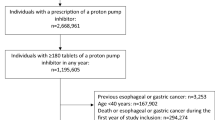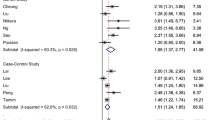Abstract
Purpose
To elucidate whether long-term proton pump inhibitor (PPI) users have an increased gastric cancer (GC) risk.
Methods
We searched the 2009–2019 Korean National Health Insurance Services Database for patients aged > 40 years who claimed for Helicobacter pylori eradication (HPE) during 2009–2014. The GC incidence following a PPI exposure of > 180 cumulative defined daily dose (cDDD) and that following an exposure of < 180 cDDD were compared. The outcome was GC development at least 1 year following HPE. A propensity score (PS)–matched dataset was used for analysis within the same quartiles of the follow-up duration. Additionally, dose–response associations were assessed, and the mortality rates were compared between long-term PPI users and non-users.
Results
After PS matching, 144,091 pairs of PPI users and non-users were analyzed. During a median follow-up of 8.3 (interquartile range, 6.8–9.6) years, 1053 and 948 GC cases in PPI users and non-users, respectively, were identified, with the GC incidence (95% confidence interval (CI)) being 0.90 (0.85–0.96) and 0.81 (0.76–0.86) per 1000 person-years, respectively. The adjusted hazard ratio (aHR) for GC with PPI use was 1.15 (95% CI, 1.06–1.25). Among PPI users, patients in the highest tertile for annual PPI dose showed higher GC development than those in the lowest tertile (aHR (95% CI): 3.87 (3.25–4.60)). GC–related mortality did not differ significantly between PPI users and non-users.
Conclusion
In this nationwide analysis in Korea, where the GC prevalence is high, long-term PPI use after HPE showed a significant increase in GC, with a positive dose–response relationship.


Similar content being viewed by others
Availability of data and materials
Due to the regulations of the Korean National Health Insurance Sharing Services, there is a limitation to the access of the database. Approval from the institution is necessary to get access to the closed server for a limited time. All relevant data are within the manuscript and its supporting information files.
References
Kinoshita Y, Ishimura N, Ishihara S (2018) Advantages and disadvantages of long-term proton pump inhibitor Use. J Neurogastroenterol Motil 24:182–196. https://doi.org/10.5056/jnm18001
Yang YX, Lewis JD, Epstein S, Metz DC (2006) Long-term proton pump inhibitor therapy and risk of hip fracture. JAMA 296:2947–2953. https://doi.org/10.1001/jama.296.24.2947
Bavishi C, Dupont HL (2011) Systematic review: the use of proton pump inhibitors and increased susceptibility to enteric infection. Aliment Pharmacol Ther 34:1269–1281. https://doi.org/10.1111/j.1365-2036.2011.04874.x
Brophy S, Jones KH, Rahman MA, Zhou SM, John A, Atkinson MD, Francis N, Lyons RA, Dunstan F (2013) Incidence of Campylobacter and Salmonella infections following first prescription for PPI: a cohort study using routine data. Am J Gastroenterol 108:1094–1100. https://doi.org/10.1038/ajg.2013.30
Xu HB, Wang HD, Li CH, Ye S, Dong MS, Xia QJ, Zhang AQ, Pan K, Ge XL, Dong JH (2015) Proton pump inhibitor use and risk of spontaneous bacterial peritonitis in cirrhotic patients: a systematic review and meta-analysis. Genet Mol Res 14:7490–7501. https://doi.org/10.4238/2015.July.3.25
Dubberke ER, Reske KA, Yan Y, Olsen MA, McDonald LC, Fraser VJ (2007) Clostridium difficile–associated disease in a setting of endemicity: identification of novel risk factors. Clin Infect Dis 45:1543–1549. https://doi.org/10.1086/523582
Lambert AA, Lam JO, Paik JJ, Ugarte-Gil C, Drummond MB, Crowell TA (2015) Risk of community-acquired pneumonia with outpatient proton-pump inhibitor therapy: a systematic review and meta-analysis. PLoS ONE 10:e0128004. https://doi.org/10.1371/journal.pone.0128004
Cheung KS, Chan EW, Wong AYS, Chen L, Wong ICK, Leung WK (2018) Long-term proton pump inhibitors and risk of gastric cancer development after treatment for Helicobacter pylori: a population-based study. Gut 67:28–35. https://doi.org/10.1136/gutjnl-2017-314605
Freedberg DE, Kim LS, Yang YX (2017) The risks and benefits of long-term use of proton pump inhibitors: expert review and best practice advice from the American Gastroenterological Association. Gastroenterology 152:706–715. https://doi.org/10.1053/j.gastro.2017.01.031
Seo SI, Park CH, You SC, Kim JY, Lee KJ, Kim J, Kim Y, Yoo JJ, Seo WW, Lee HS, Shin WG (2021) Association between proton pump inhibitor use and gastric cancer: a population-based cohort study using two different types of nationwide databases in Korea. Gut 70:2066–2075. https://doi.org/10.1136/gutjnl-2020-323845
Shin GY, Park JM, Hong J, Cho YK, Yim HW, Choi MG (2021) Use of proton pump inhibitors vs histamine 2 receptor antagonists for the risk of gastric cancer: population-based cohort study. Am J Gastroenterol 116:1211–1219. https://doi.org/10.14309/ajg.0000000000001167
Lee JK, Merchant SA, Schneider JL, Jensen CD, Fireman BH, Quesenberry CP, Corley DA (2020) Proton pump inhibitor use and risk of gastric, colorectal, liver, and pancreatic cancers in a community-based population. Am J Gastroenterol 115:706–715. https://doi.org/10.14309/ajg.0000000000000591
Abrahami D, McDonald EG, Schnitzer ME, Barkun AN, Suissa S, Azoulay L (2022) Proton pump inhibitors and risk of gastric cancer: population-based cohort study. Gut 71:16–24. https://doi.org/10.1136/gutjnl-2021-325097
Gao H, Li L, Geng K, Teng C, Chen Y, Chu F, Zhao Y (2022) Use of proton pump inhibitors for the risk of gastric cancer. Medicine (Baltimore) 101:e32228. https://doi.org/10.1097/MD.0000000000032228
Piovani D, Tsantes AG, Schunemann HJ, Bonovas S (2023) Meta-analysis: use of proton pump inhibitors and risk of gastric cancer in patients requiring gastric acid suppression. Aliment Pharmacol Ther 57:653–665. https://doi.org/10.1111/apt.17360
Uemura N, Okamoto S, Yamamoto S, Matsumura N, Yamaguchi S, Yamakido M, Taniyama K, Sasaki N, Schlemper RJ (2001) Helicobacter pylori infection and the development of gastric cancer. N Engl J Med 345:784–789. https://doi.org/10.1056/NEJMoa001999
Haastrup PF, Jarbol DE, Thompson W, Hansen JM, Sondergaard J, Rasmussen S (2021) When does proton pump inhibitor treatment become long term? A scoping review. BMJ Open Gastroenterol 8. https://doi.org/10.1136/bmjgast-2020-000563
Pottegard A, Broe A, Hallas J, de Muckadell OB, Lassen AT, Lodrup AB (2016) Use of proton-pump inhibitors among adults: a Danish nationwide drug utilization study. Therap Adv Gastroenterol 9:671–678. https://doi.org/10.1177/1756283X16650156
Lee J, Lee JS, Park SH, Shin SA, Kim K (2017) Cohort profile: the national health insurance service-national sample cohort (NHIS-NSC). South Korea Int J Epidemiol 46:e15. https://doi.org/10.1093/ije/dyv319
Seong SC, Kim YY, Khang YH, Heon Park J, Kang HJ, Lee H, Do CH, Song JS, Hyon Bang J, Ha S, Lee EJ, Ae Shin S (2017) Data resource profile: the national health information database of the national health insurance service in South Korea. Int J Epidemiol 46:799–800. https://doi.org/10.1093/ije/dyw253
Song SO, Jung CH, Song YD, Park CY, Kwon HS, Cha BS, Park JY, Lee KU, Ko KS, Lee BW (2014) Background and data configuration process of a nationwide population-based study using the korean national health insurance system. Diabetes Metab J 38:395–403. https://doi.org/10.4093/dmj.2014.38.5.395
Choi IJ, Kim YI, Park B (2018) Helicobacter pylori and prevention of gastric cancer. N Engl J Med 378:2244–2245. https://doi.org/10.1056/NEJMc1805129
Morgan E, Arnold M, Camargo MC, Gini A, Kunzmann AT, Matsuda T, Meheus F, Verhoeven RHA, Vignat J, Laversanne M, Ferlay J, Soerjomataram I (2022) The current and future incidence and mortality of gastric cancer in 185 countries, 2020–40: a population-based modelling study. EClinicalMedicine 47:101404. https://doi.org/10.1016/j.eclinm.2022.101404
Mukaisho K, Nakayama T, Hagiwara T, Hattori T, Sugihara H (2015) Two distinct etiologies of gastric cardia adenocarcinoma: interactions among pH, Helicobacter pylori, and bile acids. Front Microbiol 6:412. https://doi.org/10.3389/fmicb.2015.00412
Dacha S, Razvi M, Massaad J, Cai Q, Wehbi M (2015) Hypergastrinemia Gastroenterol Rep (Oxf) 3:201–208. https://doi.org/10.1093/gastro/gov004
Lundell L, Vieth M, Gibson F, Nagy P, Kahrilas PJ (2015) Systematic review: the effects of long-term proton pump inhibitor use on serum gastrin levels and gastric histology. Aliment Pharmacol Ther 42:649–663. https://doi.org/10.1111/apt.13324
Imhann F, Bonder MJ, Vich Vila A, Fu J, Mujagic Z, Vork L, Tigchelaar EF, Jankipersadsing SA, Cenit MC, Harmsen HJ, Dijkstra G, Franke L, Xavier RJ, Jonkers D, Wijmenga C, Weersma RK, Zhernakova A (2016) Proton pump inhibitors affect the gut microbiome. Gut 65:740–748. https://doi.org/10.1136/gutjnl-2015-310376
Seto CT, Jeraldo P, Orenstein R, Chia N, DiBaise JK (2014) Prolonged use of a proton pump inhibitor reduces microbial diversity: implications for Clostridium difficile susceptibility. Microbiome 2:42. https://doi.org/10.1186/2049-2618-2-42
Wroblewski LE, Peek RM Jr, Coburn LA (2016) The role of the microbiome in gastrointestinal cancer. Gastroenterol Clin North Am 45:543–556. https://doi.org/10.1016/j.gtc.2016.04.010
Kuipers EJ, Lundell L, Klinkenberg-Knol EC, Havu N, Festen HP, Liedman B, Lamers CB, Jansen JB, Dalenback J, Snel P, Nelis GF, Meuwissen SG (1996) Atrophic gastritis and Helicobacter pylori infection in patients with reflux esophagitis treated with omeprazole or fundoplication. N Engl J Med 334:1018–1022. https://doi.org/10.1056/NEJM199604183341603
Li Z, Wu C, Li L, Wang Z, Xie H, He X, Feng J (2017) Effect of long-term proton pump inhibitor administration on gastric mucosal atrophy: a meta-analysis. Saudi J Gastroenterol 23:222–228. https://doi.org/10.4103/sjg.SJG_573_16
Park YH, Kim N (2015) Review of atrophic gastritis and intestinal metaplasia as a premalignant lesion of gastric cancer. J Cancer Prev 20:25–40. https://doi.org/10.15430/JCP.2015.20.1.25
Abrahami D, Azoulay L (2022) Response by Abrahami et al to letter regarding article ‘Proton pump inhibitors and risk of colorectal cancer.’ Gut 71:1690–1691. https://doi.org/10.1136/gutjnl-2021-326544
Jung KW, Won YJ, Kong HJ, Lee ES (2019) Cancer statistics in Korea: incidence, mortality, survival, and prevalence in 2016. Cancer Res Treat 51:417–430. https://doi.org/10.4143/crt.2019.138
Sekiguchi M, Oda I, Matsuda T, Saito Y (2022) Epidemiological trends and future perspectives of gastric cancer in Eastern Asia. Digestion 103:22–28. https://doi.org/10.1159/000518483
Kanno T, Moayyedi P (2019) Proton pump inhibitors in the elderly, balancing risk and benefit: an age-old problem. Curr Gastroenterol Rep 21:65. https://doi.org/10.1007/s11894-019-0732-3
Xie Y, Bowe B, Li T, Xian H, Yan Y, Al-Aly Z (2017) Risk of death among users of proton pump inhibitors: a longitudinal observational cohort study of United States veterans. BMJ Open 7:e015735. https://doi.org/10.1136/bmjopen-2016-015735
Manolis AA, Manolis TA, Melita H, Katsiki N, Manolis AS (2020) Proton pump inhibitors and cardiovascular adverse effects: Real or surreal worries? Eur J Intern Med 72:15–26. https://doi.org/10.1016/j.ejim.2019.11.017
Li S, Liu F, Chen C, Zhu W, Ma J, Hu J, Xu J, Hong K (2019) Real-world relationship between proton pump inhibitors and cerebro-cardiovascular outcomes independent of clopidogrel. Int Heart J 60:910–918. https://doi.org/10.1536/ihj.18-584
Funding
This study was funded by a grant from the Korea Health Technology Research and Development Project (grant no. HC19C0060).
Author information
Authors and Affiliations
Contributions
JWK: analysis and interpretation of data, drafting of the manuscript, and revision of the manuscript; BL: statistical analysis and interpretation of data; HKJ: study concept and design, acquisition of data, obtainment of funding; CMS: study concept and design, critical revision of the manuscript; EJG, JH, YHY, and KJL: critical revision of the manuscript and study supervision.
Corresponding author
Ethics declarations
Ethical approval
The study protocol was approved by the institutional review board of Ewha Women’s University Hospital (IRB number EUMC 2020–07-028).
Competing interests
The authors declare no competing interests.
Additional information
Publisher's Note
Springer Nature remains neutral with regard to jurisdictional claims in published maps and institutional affiliations.
Supplementary Information
Below is the link to the electronic supplementary material.
Rights and permissions
Springer Nature or its licensor (e.g. a society or other partner) holds exclusive rights to this article under a publishing agreement with the author(s) or other rightsholder(s); author self-archiving of the accepted manuscript version of this article is solely governed by the terms of such publishing agreement and applicable law.
About this article
Cite this article
Kim, J.W., Jung, HK., Lee, B. et al. Risk of gastric cancer among long-term proton pump inhibitor users: a population-based cohort study. Eur J Clin Pharmacol 79, 1699–1708 (2023). https://doi.org/10.1007/s00228-023-03580-7
Received:
Accepted:
Published:
Issue Date:
DOI: https://doi.org/10.1007/s00228-023-03580-7




